Fifty five years ago this week Marcos Pérez Jiménez, dictator of Venezuela, fled from power in the face of a popular uprising and botched military coup. Among other things, Jiménez had used Venzuela’s oil to finance a pretty well-equipped military, and the nation had been an early adopter of both the FN49 and FAL rifles. Well, thanks to reader Daniel, we have a handful of photos of the January 1958 uprising. They show several rare and interesting types of firearm actually being used. Thanks, Daniel!
Venezuela purchase 5,000 FAL rifles in 1954, and was the only country to buy these guns in a caliber other than 7.62 NATO. They were instead ordered in 7x49mm “Second Optimum”, also known as 7mm Liviano. This round was a development of the cartridge debate that had been running between the US and UK, in which the UK wanted an intermediate caliber for controllability while the US insisted on a full-power round for maximum range. Several compromises were designed, and the 7×49 was one of these, firing a 140 grain bullet at about 2750fps.
Anyway, the first Venezuelan FAL order was in 7×49, and the rifles were also fitted with a somewhat distinctive three-prong flash hider. In 1961 a second batch of FALs was ordered in 7.62 NATO, and the existing guns were converted to that caliber as well. The 7mm FAL rifles existed only briefly, from 1954 to 1961, and so it’s neat to find photos of them in that configuration.
Click on any photo to enlarge…
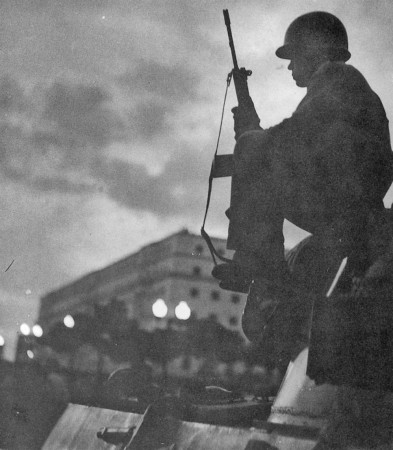
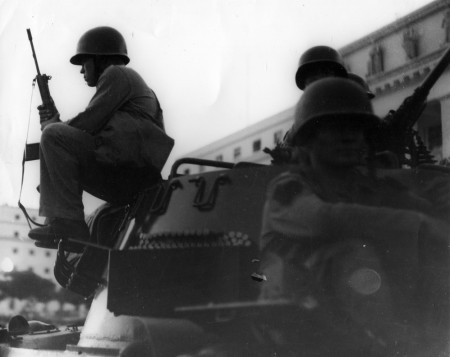
Edited to add: Leszek Erenfeicht sent us another photo of a Venezuelan FAL in action, in this case with a soldier guarding the bomb-damaged car of Venezuelan President Romulo Betancourt in 1960:
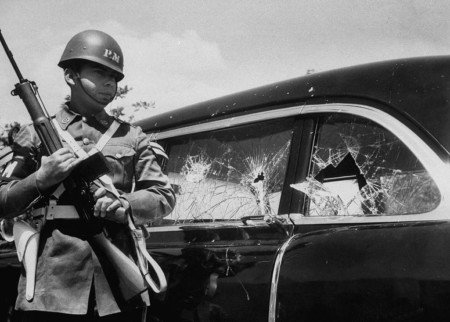
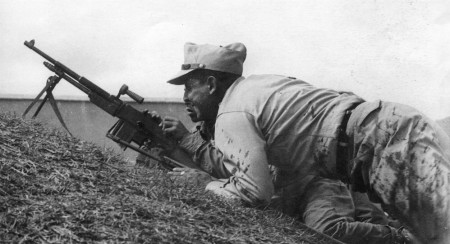
Another rifle purchased by the Venezuelan military was the FN49, which they bought 4,000 of in 1948 and a further 4,000 in 1951. The early order was in fact the first major sale of FN49 rifles made, and they were chambered for the 7×57 Mauser cartridge, which had been a standard in Venezuela (and elsewhere in South America) for many years.
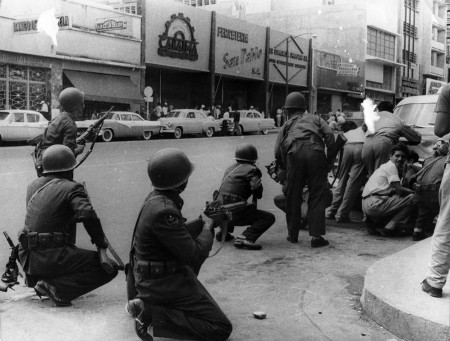
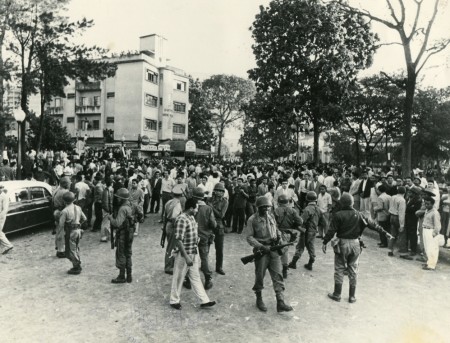
One other gun that makes an appearance in these photos is the Hotchkiss Universal folding SMG (we have a video on it showing the folding capability). Venezuela is one of the very few countries that bought these interesting subguns, and it is pretty cool to find photos showing them actually being used. It appears they were in the hands of a military bodyguard, along with M1A1 Thompson SMGs. Perhaps someone can identify the man with the microphone below?
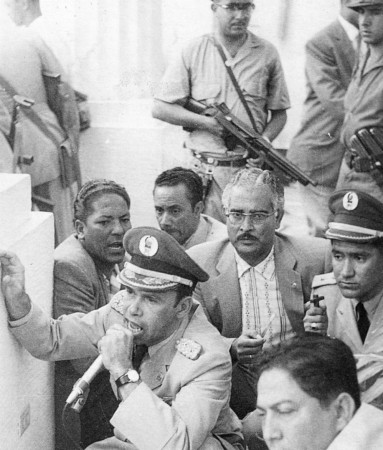
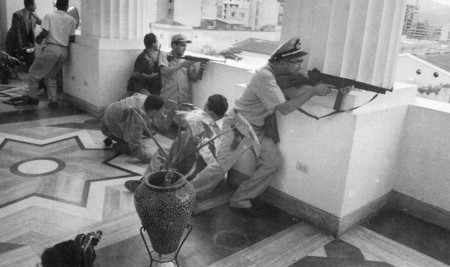

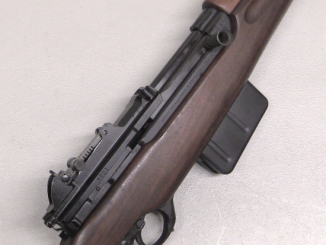

Has anyone on this site ever owned or handled an FAL in 7mm x 49? I’m guessing that the recoil characteristics are probably similar to, but slightly softer than, those of the 7mm-08 cartridge.
7 x 49 was also called “Medium”. Probably good average round. There were also 7 x 47 and 7 x 51 shots. See for more relevant reading here: http://www.quarry.nildram.co.uk/Assault.htm
This is part of discussions which never end.
I have never seen a 7mm in person but I did have a smith from the FAL files make me repro of the Vene 3 prong flah hider. I never did get a Venezuelan kit sorted out. I had it on the front of an Isralie FAL for a while. It does have a distinctive look.
lets see if I can paste pics into this comment.
.
[IMG]http://i9.photobucket.com/albums/a51/Rotor_/FAL/Moses%20Flash%20Hiders/DSCF0678.jpg[/IMG]
.
.
[IMG]http://i9.photobucket.com/albums/a51/Rotor_/FAL/Moses%20Flash%20Hiders/DSCF0682.jpg[/IMG]
.
Nice photos, John, and high-quality machining work by your gunsmith. Reminds me of the open three-prong flash hider on the early-model M-16’s. Did your flash hider work well with your FAL, especially during night firing?
I guess not
Here are links to the pics.
Pic 1
http://s9.beta.photobucket.com/user/Rotor_/media/FAL/Moses%20Flash%20Hiders/DSCF0678.jpg.html
http://i9.photobucket.com/albums/a51/Rotor_/FAL/Moses%20Flash%20Hiders/DSCF0678.jpg
Pic 2
http://s9.beta.photobucket.com/user/Rotor_/media/FAL/Moses%20Flash%20Hiders/DSCF0682.jpg.html
http://i9.photobucket.com/albums/a51/Rotor_/FAL/Moses%20Flash%20Hiders/DSCF0682.jpg
“the UK wanted an intermediate caliber for controllability” – Canada and Belgium wanted the same cartridge as Britain for the same reasons as well. This was why the FAL was designed for 7mm. It was basically the US on one side of the issue (intermediate calibre), and everyone else in NATO who had an opinion on the matter on the other side.
I believe the US wanted to switch from 30-06 because they believed the length of the cartridge caused feed problems in machine guns. Propellant compositions had made advances since the 30-06 was adopted, making it feasible to get a similar energy from a smaller cartridge case. I recall reading though that the Americans thought they could convert their existing M1 Garand stocks to 7.62×51 by using a cheap chamber insert. The chamber insert idea didn’t work out, but we ended up being stuck with 7.62×51 anyway.
“US insisted on a full-power round for maximum range” – The British 7mm cartridge was actually better at long range because it was more aerodynamic and so didn’t lose velocity as quickly, and so actually had more energy (was more powerful) at long range despite having less energy at short range. The 7.62×51 was actually the worst of both worlds – too much recoil to use in an effective assault rifle, but too poor of ballistics to make a really good long range round. It only made sense in terms of being cheaper for converting existing US rifle stocks (but that idea didn’t work out either).
P.S. – I read that most of the M1 conversion chamber inserts were destroyed, but that some made it onto the open market somehow. I understand though that rifles with this insert are unsafe to fire, which should be a warning to anyone who finds one.
The Chamber inserts I’ve seen before for sale somewhere online. The reason the insets are unsafe is that they were press fit in. And had a reputation for coming out with the brass after a couple hundred rounds, thus blowing headspace by 3/8″ for the next round.
https://www.forgottenweapons.com/navy-308-garand-conversion/
Thanks for the link. I hadn’t seen that before. I had read a few brief bits about it elsewhere, but nothing to that detail. Meanwhile, there was a story about it here that I didn’t know about.
Unfortunately, while the report tells when the tests were actually budgeted for and conducted, it doesn’t say who came up with the idea or when it was first thought of.
A major issue was that the .280 British was British and not American.
If it weren’t for MacArthur killing the .276 Pedersen a few decades earlier and insisting that the Garand be a .30-06 rifle, things would’ve worked out a lot differently. Not to mention, without the years of delay involved, it would’ve been possible for every American soldier to have a Garand by the start of World War 2.
Venezuela has cecome an early FAL trendsetter for the rest of Latin America almost by accident. After having bought SAFN 49 in 7 mm x 57 Mauser, the Venezuelan Army wanted 5000 more of these in 1953, but FN said the rifle is no longer manufactured and offered them a new one, called LAR in English (Light Automatic Rifle) or FAL otherwise (Fusil Automatique Leger in French, Fusil Automatico Leviano in Spanish). These they also wanted in 7 mm Mauser, but FN refused to make separate receivers requiered to chamber a cartridge that long, and offered the FAL to the Venezuelans in a choice of two calibers: British .280/30 (which they dubbed 7 mm FN Short) or new US/NATO T65A3 round, the 7.62×51. Two prototypes were sent over for trials, s/n 26 in .280/30, and s/n 49 in 7.62 mm. After a series of tests and negotiations, a special compromise chambering was offered, called 7 mm Second Optimum: this consisted of a long .280/30 bullet, loaded in a case of the T65A3 cartridge shortened to 49 mm in order to keep o/a length of the thus created round within that for the 7.62 mm round. BTW, the cartridge was NEVER called the 7 mm Liviano – the cartridge box’s label reads: “15 / Cartuchos / Cal. 7 m/m / Communos / Sobre Cargador / Para / Fusil Automatico / Leviano (F.A.L.) / F.N. 1955”. Maybe the faulty sobriquet came from Spanish Leviano for Light, being a part of the rifle, not cartridge designation.
On November 30, 1954 Venezuela ordered 5000 FN rifles in two configurations: the 50-00 automatic rifle, called the FAL for Fusil Automatico Leviano, and 50-42 heavy-barrelled automatic Rifle or FAP – Fusil Automatico Pesado. These rifles were fitted with disc-style sights (later to be copied by the Canadians in their C1) and three-pronged flash hiders – both of their own design and manufacture. These rifles were in early FN FAL configuration with smooth muzzle (no flash-hider thread, these were cut in Venezuela), wooden vertical pistol grip and early stepped handguard. Following batches of FAL 50-00 were ordered in standard 7.62 mm caliber and with later-style plastic pistol grip and smooth handgaurds. Along with these, extra berrels were ordered to re-barrel the 7 mm FALs and FAPs. The coup photos all show later configuration of the FAL, and may in fact show the 7.62 mm rifles. In 1974 10 000 folding 50-63 Para ARs were also purchased. These rifles remained the mainstay of the Venezuelan Army until early 2000s, when Hugo Chavez, a lefty president of the country bought Russian AK-103s, along with their factory – but that’s quite another story.
I’m sending Ian a photo of the Venezuelan Army MP (Policia Militar) with the early FN 50-00 FAL rifle standing guard by the Venezuelan president Romulo Betancourt’s limo, damaged by a bomb touched-off on June 24, 1960 by his sworn enemy, the Dominican Republic dictator, Leonidas Trujilio. Maybe he’ll post it somehow for all of you to see.
Hello, Leszek :
As usual, timely and enlightening information coming from one who knows. If Ian posts that photo you mentioned, it would be a really interesting addition to our knowledge of the recent history of the FAL rifle. Many thanks, my friend!
It is interesting to see that Venezuelan conception of truly ‘intermediate’ round was so much ahead (along with British and Belgians) in so many years ago. Now they are stuck with pretty antiquated rounds, in comparison.
Dear Leszek, the spelling of the Rifle is NOT correct. The Name of the rifle is: Fusil Automatico LIVIANO (not Leviano as in your posting)..the word Leviano doesnt exist in this context in spanish…LIVIANO do…see here: http://www.wordreference.com/es/en/translation.asp?spen=liviano
And the ammo boxes clearly read the word as LIVIANO..I have a lot of this ammo as leftovers from FN and I took them into inventory, as FN disposed them off..
There are slight differencies in bullet form and construction of all the various 7×49 for England, for the belgian tests a.s.o.
Am I the only person who noticed that the first two photographs are actually the same, just of different quality and one showing more of the armored vehicle?
Good call. Perhaps Ian included the second photograph for additional perspective?
Or he didn’t notice that they were in fact different crops of the same photo. 🙂
Thanks for an added photo, Ian – hope you all enjoyed that one, too.
Some time ago I found these pictures on the Internet:
http://i338.photobucket.com/albums/n430/petrus_optimus/Misc/Venezuelan_FAL_zps76c1c596.jpg
http://i338.photobucket.com/albums/n430/petrus_optimus/Misc/Venezuelan_FAP_zpsee6221fb.jpg
Good photos — thanks for sharing them. The “disc” ( diopter ) rear sight that Leszek Erenfeicht referred to in his 012513 / 2:02 p.m. post is readily discernible.
A FAL rifle in 7mm x 49? I did not know something like that existed.
That would explain a story I read a few years ago on the Net about a man who visited a government armory in Venezuela, and said he saw stacks of rusty FALs piled to the ceiling in one room. I always remembered that story, because of the image it left in my mind. Who could just toss away valuable rifles like that? That seemed strange, even for a Third World armory.
A weird caliber would explain why these rifles were neglected and stored away, and not sold on the open collectors surplus market. I bet them being in full auto also dropped their resale ability to us Americans.
Interesting, but hardly conceiveable to see these sold for example in the U.S. There are different priorities right now in Venezuela. From our, collectors and fans point of view it is definetely shame.
It’s a pity that after buying those 7mm FALs, Venezuela took a huge step backwards by switching from an intermediate to a full-power round.
This is what municion.org (http://www.municion.org/7×49/7×49.htm) says on the 7mm Venezuelan cartridge:
El cartucho 7×49 comenzó a ser investigado y desarrolado en el año 1950 por un equipo conjunto de técnicos Venezolanos y Belgas, con el objetivo de encontrar un cartucho apto para sustituir al 7×57 Mauser que se venía utilizando desde 1929 en las versiones de K98 realizadas por la FN.
Junto al cartucho se diseñaba el arma que debía dispararlo y que se haría famoso con el nombre de FAL.
La accidentada orografía del país, y sus vegetación con pocos claros hacen innecesario el gran alcance del cartucho (Algunos modelos españoles tenían el alza graduada hasta 2.000 metros). La talla promedio del soldado venezolano de la época aconsejaba también un cartucho y arma más pequeños. Teniendo en cuenta estos datos, se llegó a la conclusión que el Fusil de Asalto Liviano (FAL) debía recamararse para el calibre 8×33 mm o 7.92 Kurz.
Pero el usar un cartucho diseñado bajo el III Reich -por bueno que fuese- y el llamar al arma Fusil de Asalto no fue considerado políticamente correcto. El nombre se modificó a Fusil Automático Ligero, pero el cartucho representaba un problema más complejo.
En vista que Venezuela contaba con toda la maquinaria y matricería para producir el 7 mm mauser, se decidió evolucionar el cartucho sin variar el diámetro de la bala. Tres años más tarde se presentó definitivamente el 7x49mm, tras pruebas fallidas con otros como el 7x51mm Compromise.
En marzo de 1953 se recibiero los primeros 5.000 fusiles FAL junto con 3.000.000 de cartuchos para las evaluaciones pertinentes. En 1955 se recibió otro lote de cartuchos con características mejoradas.
Además del fusil de asalto FAL, pequeños lotes de fusiles SAFN-49 y FN-Mauser 1929 se adaptaron al nuevo cartucho.
Finalmente, la adopción del 7.62×51 NATO hizo que se abandonase todo el proyecto y se comprasen FAL en dicho calibre.
I took a look at the original article and found it to be most informative. Thank you for providing the link!
comments on FN 49 in 7.92×33 Kurz for Venezuela?
Here is a case of the ammo up for auction if anyone needs it.
https://hibid.com/lot/76151050/fn-venezuelan-7mm-ammunition-crate-800–rounds/?g=all-categories&cpage=9&ipp=100&q=&ref=catalog
I think I have the last of the FALs in 7×49. They no longer exist because almost all of them were converted to 7.62×51 at the time. I have about 5,000 original cartridges, but I wanted to see if I could get the dies to reload it, as well as a reloading table. If you want photos or any information about the weapon, I’d be happy to provide it.